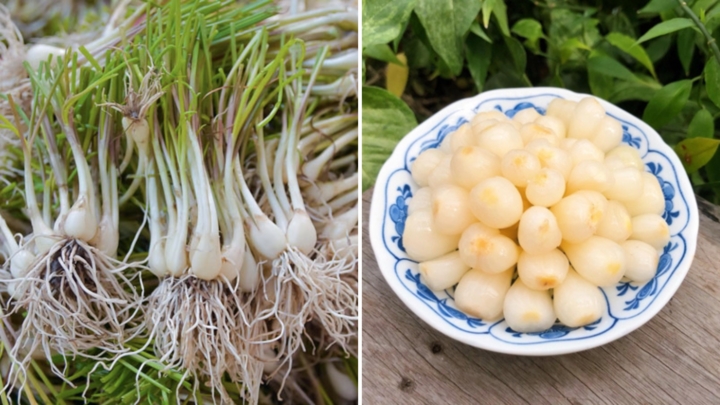Leek is the bulb of the leek plant – a type of onion family, with a white stem and a pear-shaped bulb, often used for pickling or eaten as a herb.
The sour, sweet and crispy taste of pickled leeks will make your meal more delicious and reduce the greasiness when eating meat and fish dishes. Not only tasty, leeks also have the effect of warming the stomach, relieving bloating and regulating blood flow, which is very beneficial for health.
According to the experience passed down from the past, it is advisable to soak the leeks with ashes when pickling. This preprocessing step brings unexpected effects.
Why should leeks be soaked with ashes when pickling?
After buying the leeks, you leave them intact or trim them but not too close to the base, to avoid water infiltrating into the bulb. Next, you soak the leeks in a basin of water mixed with kitchen ashes in a ratio of 1 liter of water and one scoop of kitchen ashes for every 500 grams of leeks.
Soak for about 8 – 10 hours or overnight, do not soak longer as it will make the leeks soft and rotten.
Why should leeks be soaked with ashes when pickling? In the kitchen ashes, there are several minerals that effectively help eliminate odors. The ashes also help clean the dirt, making the leeks crispy for a long time. The leeks soaked in kitchen ashes will release less water, quickly absorb the seasoning, and last longer after salting.
In addition, soaking leeks in water will make it easier to peel off the outer layer, and the result is a beautiful white leek.

Why should leeks be soaked with ashes when pickling? Ashes help reduce the odor, help leeks quickly absorb seasoning, stay crispy and last longer. (Illustration: Pinterest)
After soaking the leeks, you scoop them out and do not rinse them with water. Let the leeks drain and then dry them in the sun to reduce moisture, which will keep them crispy for a long time. After drying, you can wash them with water to clean, then soak them in vinegar or pickle them.
Note that if the pickled leeks are sour and sweet, you should use white vinegar, not rice vinegar, as it will make the leeks turn yellow and not look nice.
In addition, you should choose leeks that have a swollen base, small tail, and thin leaves, so that after pickling they will be crispy and fragrant. Large, juicy leeks are often soft and not crispy when pickled.
Tips for choosing good leeks
Currently, there are 2 main types of leeks on the market, which are Hue leeks (clove leeks) and buffalo leeks. To match the taste of pickled leeks, you should choose Hue leeks with the characteristics of swollen stem, fairly large bulb, many roots, thin leaves, slender leeks, clearly tightened, connected tail and pungent taste.
Choose leeks of medium size and even size, fresh green, not crushed or signs of mold.
How to store leeks
Generally, leeks soaked in vinegar, salt and sugar will last a long time. However, the longer they are stored at room temperature, the sourer the leeks will be. Therefore, when the leeks are ripe enough to eat, you should keep them in the refrigerator compartment to make the dish sourer.
Use clean, dry chopsticks to pick up the leeks. Do not use oily chopsticks or other food to pick up the leeks as it will spoil the leeks in the jar.
In case you pick up the leeks on a plate but cannot finish them, you can wrap them with plastic wrap and store them in the refrigerator, without pouring them back into the jar.
According to VTC news

































